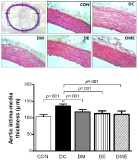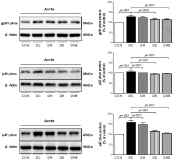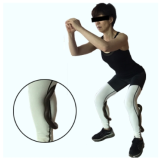
Purpose The purpose of this study was to investigate the effect of treadmill exercise and MitoQ treatment on NADPH oxidase, antioxidation and vascular function-related factors in aortic of D-galactose-induced aging rats. Methods To induce the animal model of aging, D-galactose was diluted in saline, and a dose of 100mg /kg was intraperitoneally injected into Sprague-Dawley rats once a day for a total of 10 weeks. Rats were divided into five groups: Control group (CON, n=9), D-galactose control group (DC, n=9), D-galactose+MitoQ group (DM, n=9), D-galactose+Exercise group (DE, n=9), D-galactose+MitoQ + Exercise group(DME, n=9), and treadmill exercise was conducted for 5 days/week during 8 weeks with gradual increase of intensity. MitoQ treatment was intraperitoneally injected at a concentration of 100μM/kg twice a week for 8 weeks during the research period. Results The result showed that treadmill exercise and MitoQ treatment decreased the expression of NADPH oxidase level and increased antioxidant enzyme such as SOD-2, catalase. It lead to positive effects such as increasing the level of eNOS, a protein involved in vascular function while decreasing the level of VCAM-1. In addition, as a result, it showed the structurally reduced intima-media thickness. Conclusions It can be concluded that treadmill exercise and MitoQ treatment are effective in ameliorating and treating vascular dysfunction resulting from aging.





Purpose The purpose of this study was to investigate the effect of a 10-week aerobic exercise training on cardiovascular function, atherosclerosis, and vascular endothelial function in elderly women. Methods Twenty impaired fasting glucose (IFG) and normoglycemic elderly women volunteered to participate in the study. The participants in aerobic exercise training group (TR: n=9) completed 20-40 minutes of aerobic exercise program at 30-50% HRR for 3 times per week during 10 weeks. The participants in control group (CON: n=11) were asked to maintain their normal life pattern during the same intervention period. Results Main results of the study were as follows: 1) There were no significant main effect or interaction in body weight, fat-free mass, fat mass, percent body fat, and body mass index. 2) There were no significant main effect or interaction in heart rate, stroke volume, cardiac output, total peripheral resistance (TPR), systolic blood pressure, diastolic blood pressure, mean arterial blood pressure, pulse pressure, and rate pressure product. However, interaction between group and test in TPR was close to statistically significant level (P =.054), and it tended to be decreased in TR group. 3) There was a significant main effect of test in high sensitivity C-reactive protein(hs-CRP), it tended to be decreased in TR group. There were no significant changes in total cholesterol(TC)/high density lipoprotein-cholesterol (HDL-C) ratio, triglyceride/HDL-C ratio, and low density lipoprotein-cholesterol/HDL-C ratio. 4) There were significant main effect of group, main effect of test, as well as interaction between group and test in % flow mediated dilation(FMD), and it increased significantly (P<.01) in TR group. Nitric oxide tended to be increased in TR group, even though it did not change significantly in both groups. Conclusions It was concluded that the 10-week aerobic exercise training would be beneficial for improvement of vascular endothelial function, resulting from the decrement of total peripheral resistance.
PURPOSE This study aims to investigate the effects of a 12-week equipment-based Pilates training on physical fitness, cardiovascular function, and vascular endothelial function in obese middle-aged women. METHODS Twenty-four women, aged 30-40 years with a body mass index ≥ 25 and percent body fat ≥ 30% were randomly assigned to one of two groups: the Pilates training group (TR; n=12); and control group (CON; n=12). The TR participants underwent three 50-minute equipmentbased Pilates training sessions per week for 12 weeks. Participants in the CON maintained their normal life patterns for the same intervention period. Variables regarding physical fitness, cardiovascular function, and vascular endothelial function were measured and compared pre-test and post-test u a two-way ANOVA with repeated measures. RESULTS The main results of the study were as follows: 1) Regarding physique and body composition, participants’ body weight, body mass index, fat mass, percent body fat, waist circumference, hip circumference, and waist-to-hip ratio decreased significantly in the TR. 2) Regarding physical fitness, muscle strength, muscular endurance, flexibility, and cardiorespiratory endurance increased significantly in the TR. 3) Regarding cardiovascular response, SV increased significantly in the TR. 4) Regarding vascular endothelial function, blood vessel diameter at rest and during vasodilation as well as blood flow volume during vasodilation decreased significantly in the CON, resulting in a significant interaction between group and test in FMD percentage. CONCLUSIONS It was concluded that the 12-week equipment-based Pilates program improved the physical fitness and vascular endothelial function in obese middle-aged women.

The purpose of this study was a investigate the endothelial function of prehypertensive during dynamic exercise. Hypothesis of this study was to impair the endothelial function in prehypertensive compared to normtensive during dynamic handgrip exercise. Eleven healthy prehypertension (24±2 yrs) and ten healthy normotensive (25 ± 2 yrs) were recruited in this study. Participants were performed dynamic handgrip exercise in one contraction per second at 30% of maximum voluntary contraction for three minutes. Vascular (blood vessel diameter, blood flow) and cardiar response (stroke volume, heart rate and cardiac output) were measured at rest and during exercise. Flow mediated dilation (FMD) was decrease significantly in prehypertensive less than normotensive (p<0.05) at rest, and vasodilation of prehypertensive was reduced significantly less than normitensive during exercise (p<0.05). All the cardiovascular responses were aot significantly different at rest and during exercise between prehypertensive and normotensive. These results suggest that endothelial function is impaired in prehypertensive compared to in normotensive


Purpose This study was designed to investigate the effects of weight-bearing exercise and CareRing treatment on cardiovascular responses, popliteal vein functions, and vascular elasticity of 30-40s women who had worked longer than eight hours a day in a standing position. Methods Thirteen subjects participated in 30 min of standing up treatment (STAND), weight-bearing exercise treatment (EX), and weight-bearing exercise with CareRing treatment (EX+RING). Each subject took part in the three trials repeatedly in a counter-balanced order and proceeded with a wash-out period of at least one week between the respective trials. Results The main results were as follows: 1) Significant reduction in EDV, no change in the diameter of popliteal vein, trend of reduction in blood flow of popliteal vein, and increased baPWV, indicating reduction of vascular elasticity of whole body, were shown in the STAND. 2) CO and EF increased significantly, and TPR decreased significantly in the EX. Blood flow velocity and blood flow volume of popliteal vein increased significantly, and baPWV decreased significantly from immediately after the treatment throughout the recovery phase in the EX. 3) HR, CO, and EF increased significantly in the EX+RING. Blood flow velocity and blood flow volume increased significantly in the EX+RING. Diameter of popliteal vein increased significantly immediately after the treatment and decreased significantly at 40 minutes of recovery. TPR and baPWV decreased significantly immediately after treatment compared to the STAND. Conclusions It was concluded that weight-bearing exercises would be effective in preventing venous or cardiovascular diseases occurred due to long-standing in 30-40s women, who are at high risk for such diseases. Furthermore, it would be more effective to combine pressure treatment with CareRing during weight-bearing exercises.

PURPOSE The purpose of this study was to investigate the effects of 8-week aerobic exercise and polyphenol intake on body composition, cardiovascular response, vascular endothelial function, and physical fitness at rest and during exercise in prehypertensive men. METHODS The study included twenty-eight males in their 20-30 years of age with prehypertension. Participants in the aerobic exercise + polyphenol intake group (EX + PP; n = 14) performed aerobic exercise three sessions/week, 30 min/session, at 65% of the heart rate reserve, and consumed polyphenol (grape seed extract 300 mg) for 8 weeks. Participants in the aerobic exercise + placebo intake group (EX + PL; n = 14) performed the same aerobic exercise; however, they consumed placebo instead of polyphenol. All independent variables were measured at pre-test and post-test, and the data were analyzed. RESULTS The main results of the study were as follows: 1) SBP and MAP at rest decreased significantly in EX + PP, while MAP decreased significantly in EX + PL group. 2) In the EX + PP group, CO increased significantly, whereas DBP, MAP, and TPR decreased significantly during the hand grip exercise. In contrast, CO decreased significantly, while DBP and TPR increased significantly in the EX + PL group during the hand grip exercise. 3) Regarding vascular endothelial function, % FMD increased significantly in EX + PP group. 4) Sit-up increased significantly in both EX + PP and EX + PL groups; however, sit-and-reach in EX + PP group was significantly higher than that in EX + PL group at post-test. CONCLUSIONS The findings of this study showed that the 8-week aerobic exercise would have positive effects on body composition, cardiovascular response, and physical fitness at rest and during exercise in hypertensive men. Additionally, polyphenol intake would contribute more towards reduction of blood pressure at rest and during exercise and improvement of vascular endothelial function.
PURPOSE Blood pressure (BP) in hypertensive individuals is reduced by the accumulation of post-exercise hypotension (PEH) induced by a long period of training. This study aimed to investigate the effects of intensity of two different aerobic exercises with identical energy expenditure on post-exercise blood pressure and cardiovascular function in prehypertensive men. METHODS Eleven prehypertensive men in their 30s participated in two trials repeatedly. In the first trial, the exercise was moderate in intensity and continuous (MICE) with 70% of VO2max, and the exercise in the second trial was high-intensity interval exercise (HIIE) with 50% and 90% of VO2max. Each exercise was performed for 30 min, and the variables related to BP and cardiovascular function were measured at certain times for 1 hr during the recovery phase. RESULTS Our main findings are as follows: (1) Systolic blood pressure was significantly lower at 30 and 45 min of recovery time than the baseline in the HIIE trial, and systolic blood pressure was significantly lower in the HIIE trial than the MICE trial at 10, 15, and 30 min of recovery time. (2) The rate pressure product was significantly higher in the HIIE trial than the MICE trial at 15, 30, 45, and 60 min of recovery time. (3) The heart rate was significantly higher in the HIIE trial than the MICE trial at 15, 30, 45, and 60 min of recovery time. (4) Stroke volume was significantly lower in the HIIE trial than the MICE trial at 30 min of recovery time. (5) Cardiac output was significantly higher in the HIIE trial than the MICE trial at 15 min of recovery phase. (6) Total vascular conductance was significantly higher in the HIIE trial than the MICE trial at 15 and 30 min of recovery phase. (7) Total peripheral resistance was significantly lower in the HIIE trial than the MICE trial at 15 and 30 min of recovery phase. CONCLUSIONS The HIIE shows a higher cardiovascular stress than MICE; however, HIIE contributes to the augmentation of PEH and improvement of cardiovascular function. Therefore, HIIE rather than MICE should be suggested in BP control and enhancement of cardiovascular function in prehypertensive males.